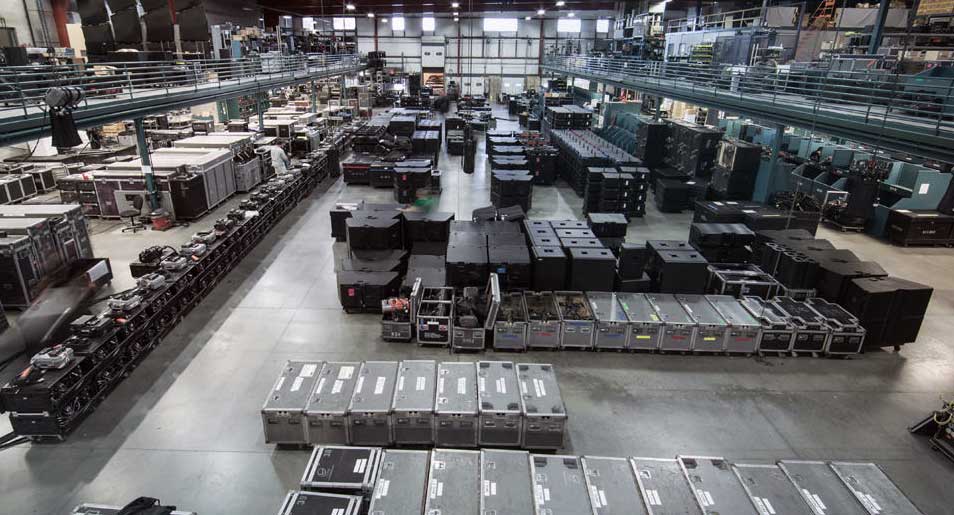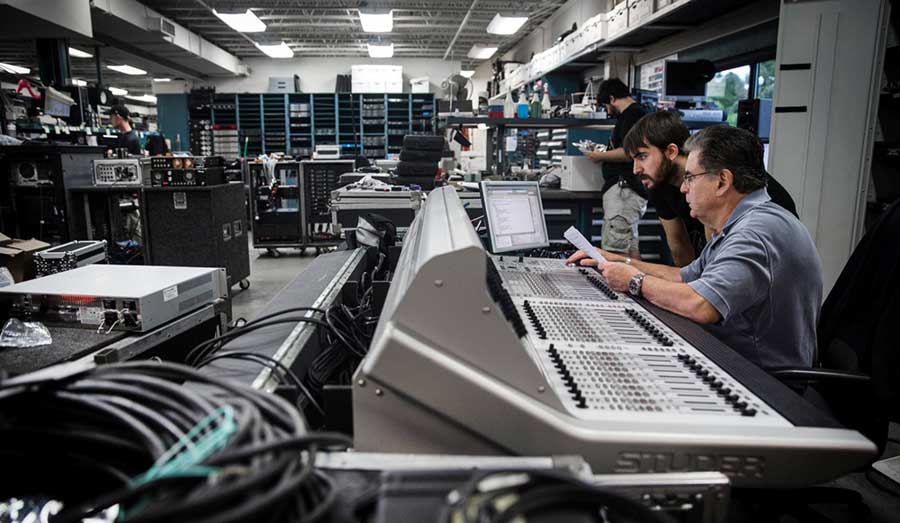
Big box concert shopping: an inventory room at Clair, the top live event touring company in the world, based in Litiz, PA. (Photo courtesy Clair Global)
For nerds who love rock music, there are few careers as promising as engineering for a production sound firm. Clair Global is the largest, operating from headquarters in Lititz, PA, the company serves the needs of the live touring concert industry, festival and rehearsal clients, and broadcast and corporate projects. The company does everything from piano tuning to instrument hauling and speaker rental. The turn-key firm packages tours for some of the biggest acts on the planet. “A napkin sketch can come in, and we do the audio design — we know what venues the artists is hitting and we design a system to meet their needs, package it up, provide crew, and all of that travels with the artist for the duration of the tour, anywhere in the world,” company marketing chief James Hammer explains. With outposts in Japan, Australia, Switzerland, the UK and South America, “our global presence ensures that our clients get consistent quality across the continents.”
Clair manufactures its own speakers and audio gear, pairing it with high-end third-party boards and electronics for what its website touts as “audio engineered to perfection.” These days, whether you’re talking about a mega-concert with flying stages, a phalanx of dancers and pyrotechnics, or just a high-end blues band with an ear toward quality, today’s live performances are intricate feats of digital magic — dozens of intersecting radio frequencies and mixes on the fly, all of which Clair has a role in coordinating.
The company, a family-owned business launched in 1966 by brothers Gene and Roy Clair (to support a Frankie Valli and the Four Seasons concert) went on to help music touring evolve, through the design and manufacture in the ’70s of things like 32-channel parametric consoles and the first “hanging sound” platform system for arena shows. The company has nearly 500 employees worldwide and provide things like data services and communications support in addition to equipment rental. Clair also offers extensive training for those who want to enter the industry. It is part of the 30-company Rock Lititz Community collaborative operating on a 96-acre campus where tours can be designed, mounted and launched — from lighting to robotics and sound design. It’s a 21st century touring enterprise with a lot of insight and institutional knowledge to share. MaxTheTrax got time with Clair Global Senior System Design Engineer Randy Lane, who explained the intricacies of the company’s art and science.
MaxTheTrax: Nowadays, the mega tours are a mix of indoor and outdoor venues, often for the same act. Is there such a thing as a routine show when you’re trying to optimize performance sound?
Randy Lane: Each and every show is a unique and diverse event and even if a performance is in the same venue for days or weeks each show has it’s own dynamics and character. We try to control the aspects of the coverage — things like sound level and frequency response — as closely as we can with changes in attendance as well as environmental changes. Temperature and humidity levels weigh greatly on sound propagation and have to be addressed each night. Audiences react differently each night which adds energy or takes it away from the performances. Each night is it’s own unique universe. Indoor shows remove the weather element unless the fire suppression systems accidentally come on. And yes, that has happened. So much for being indoors and not worrying about the weather!!!
MaxTheTrax: Can we run down some of the popular approaches to live performance? Do the overwhelming majority of live acts actually “perform” live, or is there now, with digital technology, a somewhat standard formula for blending some live, to a backing track?
Randy Lane: One aspect that is very interesting lately is the addition of a guest artist by way of video. A couple of examples are Carrie Underwood’s “Play On Tour” that incorporated a guest appearance by Randy Travis for one song, and recently the late Robin Gibb joined his brother Barry by way of video footage for a duet on Barry Gibb’s “Mythology” tour. This technology enhances the show and provides a means for performances that otherwise would not be practical or perhaps no longer possible.
MaxTheTrax: Okay, interesting answer, even though you managed to duck the question. I’ll have to tackle that in a separate article — no spoiler alerts from you! So, what would you say is the most innovative new piece of concert gear, and what does it do?

Clair is a family-owned business that employs roughly 500 people, in areas that include digital communications and audio equipment for concerts. (Photo courtesy Clair Global)
Randy Lane: I have to generalize here and say that wireless control of PA systems has greatly increased our capabilities and effectiveness. The addition of wireless interlinks for remote speaker locations is also a very promising area. With this increased control has come increased complexity so it’s a two edged sword.
MaxTheTrax: Have the technological trends created new staffing positions, in terms of necessary tour personnel, to operate and maintain this cool new gear?
Randy Lane: For the everyday touring personnel the amount of knowledge needed has increased many times over the last few years. Not only must tour personnel be audio specialists but now wifi and computer savvy too. This hasn’t created more positions in the touring industry but rather placed a much more diverse requirement of knowledge upon the [existing] touring crews.
MaxTheTrax: What kind of training is required to be able to professionally operate this gear?
Randy Lane: Training never stops. At Clair, new products are demonstrated and taught to new touring personnel by our Training Department as well as periodic System Engineer classes to maintain a consistent knowledge base.
MaxTheTrax: Any one thing that you would advise giving extra pre-planning attention in order to make the live show run smoothly?
Randy Lane: Always have a backup plan in place for power sources as well as console and drive lines/protocols to minimize downtime in the event of power failures, accidental in-show damage to critical systems, and equipment failures. If it’s absolutely vital to the show then have a backup plan and device. In addition, test that backup to make sure it functions as intended.
MaxTheTrax: What is the most unusual, or challenging, surprise circumstance you had to think-on-your-feet and deal with in a live situation? (Or request you’ve had from a touring band, in terms of an accommodation required/desired?)
Randy Lane: For Pope Francis’ 2015 visit to Philadelphia and the Mass service that was held there, Clair was tasked with providing sound reinforcement for the Saturday night performances, which included Aretha Franklin and over 20 other artists as well as a 100-plus piece orchestra. The Saturday night performance was held on the structure and stage which was to serve as the venue for Mass Service the very next morning. Immediately after the performances were over on Saturday night the entire orchestra as well as monitoring system for the orchestra had to be moved from the World Meeting of Families stage to a point behind the Front of House consoles. This placed the orchestra in front of the main PA system which is a situation that is unusable. To enable this position to work, Clair’s design team provided a secondary orchestra-only PA system for the Papal Mass on Sunday. This was accomplished overnight in time to be ready for Sunday Mass. There was no discussion of how it couldn’t be done, but rather “what’s the next step in making it happen?” Surprises happen in planning extremely large events. Early planning helps but cannot alleviate the inevitable “oh by the way” crisis that will always come up. That’s where experience and the right attitude comes to the rescue.
2 Responses to "Live Event Sound for the 21st Century"
Comments are closed.


Hello,my name is Daniel Benoit 21 years old,I would like to have your help,because I have a idea to put a sound company in Haiti,I think you can be my partner
Hi Daniel, I don’t think I would have the time or expertise to help you, but it’s a good idea. Go for your dream!